The EPCAMR Staff are innovators when it comes to ways to create innovative and creative ways to use iron oxide that allow it to be viewed as unique and useful rather than just as a pollutant in abandoned mine drainage (AMD) that pollutes many of our regional rivers and streams. By taking iron oxide out of streams and reusing it, EPCAMR has found many ways to recycle something that would normally remain in the water systems, creating biological dead zones until the mines are completely devoid of heavy metal deposits – a problem that would take decades, probably even centuries, to completely cease naturally. This story is one of may that is long overdue and thanks to our Community Relations Intern, Gabby Zawacki, we’re finally being able to play catch up and report on all the great stories and projects that we’ve been up to over the last few seasons. It’s very difficult to write stories and manage all the projects at the same time. “I’m just very happy that we have Gabby here with her background in Literary Arts and her phenomenal writing skills to put together the stories that we’ve always wanted to tell, but just don’t have as much time as we would like to tell the whole story. Now, at least for the entire Spring Semester, through mid-May, Gabby is going to be able to do that for EPCAMR”, Robert Hughes, EPCAMR Executive Director, enthusiastically stated. As of May 2012, EPCAMR, through a partnership between Wilkes-Barre Area School District and funding from PPL, was able to finish construction on a project that allows them to take their environmentally friendly iron oxide reclamation to the next level: Completion of the first ever constructed Mobile Solar Kiln for drying AMD to be used for demonstrations and environmental education programs in many of the underserved elementary schools within the City of Wilkes-Barre.
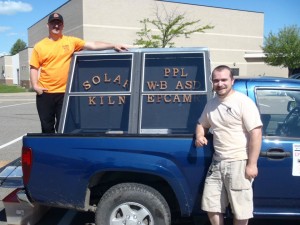
Robert Hughes, EPCAMR Executive Director, and Michael Hewitt, EPCAMR Program Manager, stand with the Mobile Solar Kiln for processing AMD before off-loading it at Plains-Solomon Elementary School.
The Mobile Solar Kiln for processing AMD, which grew out of a desire by Robert Hughes, EPCAMR Executive Director to get “off the grid” became a reality when PPL and the W-B Area School District decided to partner with EPCAMR in order to make the project a reality upon being awarded a $2000 grant written by EPCAMR. EPCAMR worked with Mike Corcoran, Science Coordinator to partner on the grant. Alana Malar Roberts, who at the time was PPL’s Community Outreach Coordinator, was also integral in providing us with public relations on the project and assisted us with coming out and seeing the kids work with us on the project. Mike happened to be a former Assistant Coach of Robert’s when he was in Jr. High School at the Grand Army of the Republic (G.A.R.).
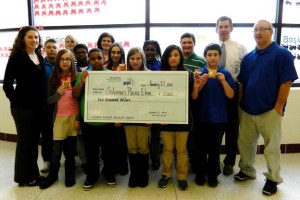
Students gather with PPL, EPCAMR, and W-B Area School District at Leo E. Solomon Plains to receive the grant check.
Spring 2012 EPCAMR interns Dan Gilbert, Ryan Lawrence, and Zach Yodis, all from King’s College, helped Robert Hughes, Executive Director, and Michael Hewitt, Program Manager, complete the construction of the project.

Interns Dan Gilbert, Zach Yodis, and Ryan Lawrence helping Michael Hewitt, EPCAMR Program Manager, construct the wooden frame for the Mobile Solar Kiln for processing AMD.
Construction of the kiln consisted of creating the solar collector and kiln oven. The solar collector apparatus, made of PVC pipes and three solar panels, is capable of collecting 45 watts of power, which powers a recycled computer cooling fan that can be automatically turned on should the temperature get too hot inside of the kiln or if excess moisture was to build up on the recycled single-pane windows.
The old coal home windows that were also used as a part of the construction came from the Executive Director’s first home where he had replaced his windows with more energy efficient windows. The solar panel unit sends the excess electrical power that is generated back to a motorcycle battery for storage when the cooling fan is not in use or turned on. EPCAMR has been able to reach 200 degrees Fahrenheit on a day when it was 95 degrees outside.
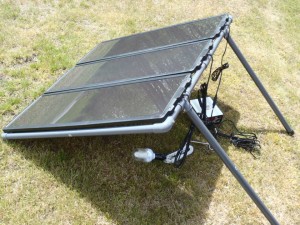
The completed solar collector beginning to capture its first rays of sunshine before being connected to the battery backup unit!
The kiln oven was constructed out of standard pressure treated 2″ x 4″ wood and recycled single-paned storm windows. The windows serve a dual purpose. By allowing extra sunlight into the kiln, the windows allow the kiln to generate extra heat than just using the solar collector alone. In addition, the windows allow anyone using the kiln to watch the iron oxide reclamation process at work as it begins to dry the pigment and decant the water moisture, making it an awesome visual feature for projects with local school districts. After the wooden frame was painted a powder coat black, which helped the system to absorb the additional heat much like culm does on an abandoned coal bank, it was assembled , complete with wheels to make it mobile, and the windows were installed, leaving the solar kiln ready to be stained in a polyurethane mixture with EPCAMR’s signature iron oxide pigment color: Yellow Boy Orange.
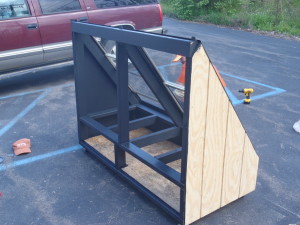
EPCAMR’s Solar Kiln getting painted in the black powder coat prior to putting on the Yellow Boy iron oxide stain on the outside panels
The EPCAMR Solar Kiln, completed almost 2 years ago, has been a great success in allowing EPCAMR to reclaim iron oxide “off the grid.” The kiln, which can reach upwards of 200 degrees is more than capable of effectively heating and drying iron oxide that EPCAMR uses in its AMD Tie-Dye Workshops, AMD Chalk Talks and Art Projects, and coming soon: AMD Pottery workshops. In addition, the kiln is a great way to get local school districts excited about “off the grid” energy options. When the kiln was first completed, EPCAMR traveled to the Leo E. Solomon-Plains Elementary School to work with the entire 5th and 6th grade students (230) and to teach then about AMD and the ways iron oxide can be used.
The students completed an AMD Tie-Dye workshop using recovered iron oxide from the Solar Kiln. The day was filled with fun art projects and lots of education about AMD and the ways it can be reused. The students also assisted EPCAMR with painting their own Solar Kiln that was a second smaller kiln constructed by the EPCAMR Staff in the Spring of 2013 that was left for the students to use year round.
The students made the AMD Tie-Dye t-shirts that were worn on their 6th grade field trip to the Smithsonian Institute and other places around the Philadelphia area at the end of the school year and for the last two years, have been the topic of conversation when they go. It has become an annual tradition to use the Solar Kiln to make their t-shirts now. EPCAMR still has enough material to make a third Solar Kiln and will be donating it to the Heights Elementary school, once the organization can dedicate enough staff and internship time to completely build the third kiln. Heights Elementary is the alma mater of Robert Hughes, EPCAMR’s Executive Director.
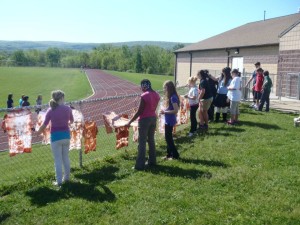
Students at Leo E. Solomon/Plains Elementary School hang their AMD Tie-Dye t-shirts up to dry. Students used iron oxide from the Solar Kiln to create their annual 6th grade field trip t-shirts.
Another element that we added to the environmental education program that we held at Leo E. Solomon-Plains Elementary was the construction of a solar-powered race car exhibition by Ann Devine, Environmental Education Coordinator for the PA Department of Environmental Protection. The students enjoyed creating the miniature race cars with rubber bands, balsam wood, and a 2″ square solar cell, batteries, and of course, wheels.
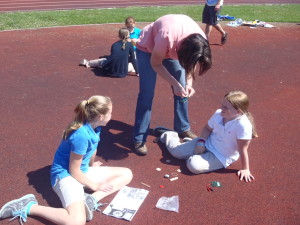
Ann Devine-PA DEP EE Coordinator working with students to help them build their solar powered race cars.
Robert emphasized, “The solar kilns, and the projects that can be completed with it, allow students to directly interact with their environment and allows us to showcase the innovative ways in which we are cleaning up our surrounding watersheds. Getting the younger generation interested and involved is the first step towards creating a lasting impact on their desire to learn about AMD, how it can be remedied, and how the iron oxide collected can be used in useful and innovative ways. So far, the solar kilns have been a great way to achieve this! EPCAMR intends to bring our Mobile Solar Kiln to other school districts and events going forward in 2014. We get a lot of mileage out of it’s use nowadays because we can basically bake 8 cake trays full of iron oxide in one day, when a few years ago, we started with cake pans that were the size of the pans that went into an Easy Bake Oven. We look forward to building our third solar kiln this Summer and getting up to Heights Elementary in the City of Wilkes-Barre. Students will be able to explain solar energy to their teachers and the EPCAMR Staff. Students will be able to recognize and know three types of abandoned mine pollution impacts to the Susquehanna River. Students will be able to speak on recycled uses for EPCAMR’s iron oxide collected from the AMD Treatment Systems and AMD Discharges. Students will be able to locate and know what the names of their local streams. Teachers will be able to inform EPCAMR of the times that they will be able to incorporate any reference materials and curriculum materials into their school curriculum. Students will learn about Anthracite Geology and three types of rocks common to the Wyoming Valley and three types of metals that commonly are contained in AMD. These are all learning objectives that we hope to instill into the youth in our area.
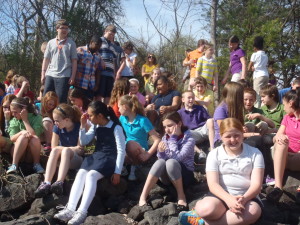
Leo E. Solomon-Plains students on an AMD Field Tour to Newport Township’s Lake of AMD, called Loch Mess on a hot humid Summer Day.
I can’t wait to go back to my old elementary school to work with the kids in the classrooms that I haven’t been back to since the late 70’s and mid-80’s. I’m anticipating the build and the visits to work with the kids and teachers, many of which, are close friends of mine who teach and were former students of the school themselves at the same time that I was a student there. A straight A student, I might add. Check out Channel 16’s Power to Save video that was filmed with the students who did an excellent job of reporting on what they had learned during the project and were excited to talk about. http://wnep.com/2013/05/09/students-turning-waste-and-pollution-into-art/







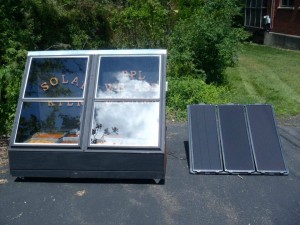







You must be logged in to post a comment.